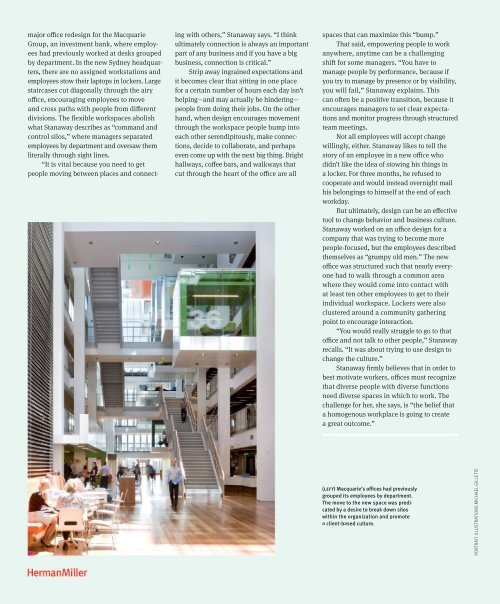Architect 2016-01
You also want an ePaper? Increase the reach of your titles
YUMPU automatically turns print PDFs into web optimized ePapers that Google loves.
major office redesign for the Macquarie<br />
Group, an investment bank, where employees<br />
had previously worked at desks grouped<br />
by department. In the new Sydney headquarters,<br />
there are no assigned workstations and<br />
employees stow their laptops in lockers. Large<br />
staircases cut diagonally through the airy<br />
office, encouraging employees to move<br />
and cross paths with people from different<br />
divisions. The flexible workspaces abolish<br />
what Stanaway describes as “command and<br />
control silos,” where managers separated<br />
employees by department and oversaw them<br />
literally through sight lines.<br />
“It is vital because you need to get<br />
people moving between places and connecting<br />
with others,” Stanaway says. “I think<br />
ultimately connection is always an important<br />
part of any business and if you have a big<br />
business, connection is critical.”<br />
Strip away ingrained expectations and<br />
it becomes clear that sitting in one place<br />
for a certain number of hours each day isn’t<br />
helping—and may actually be hindering—<br />
people from doing their jobs. On the other<br />
hand, when design encourages movement<br />
through the workspace people bump into<br />
each other serendipitously, make connections,<br />
decide to collaborate, and perhaps<br />
even come up with the next big thing. Bright<br />
hallways, coffee bars, and walkways that<br />
cut through the heart of the office are all<br />
spaces that can maximize this “bump.”<br />
That said, empowering people to work<br />
anywhere, anytime can be a challenging<br />
shift for some managers. “You have to<br />
manage people by performance, because if<br />
you try to manage by presence or by visibility,<br />
you will fail,” Stanaway explains. This<br />
can often be a positive transition, because it<br />
encourages managers to set clear expectations<br />
and monitor progress through structured<br />
team meetings.<br />
Not all employees will accept change<br />
willingly, either. Stanaway likes to tell the<br />
story of an employee in a new office who<br />
didn’t like the idea of stowing his things in<br />
a locker. For three months, he refused to<br />
cooperate and would instead overnight mail<br />
his belongings to himself at the end of each<br />
workday.<br />
But ultimately, design can be an effective<br />
tool to change behavior and business culture.<br />
Stanaway worked on an office design for a<br />
company that was trying to become more<br />
people-focused, but the employees described<br />
themselves as “grumpy old men.” The new<br />
office was structured such that nearly everyone<br />
had to walk through a common area<br />
where they would come into contact with<br />
at least ten other employees to get to their<br />
individual workspace. Lockers were also<br />
clustered around a community gathering<br />
point to encourage interaction.<br />
“You would really struggle to go to that<br />
office and not talk to other people,” Stanaway<br />
recalls. “It was about trying to use design to<br />
change the culture.”<br />
Stanaway firmly believes that in order to<br />
best motivate workers, offices must recognize<br />
that diverse people with diverse functions<br />
need diverse spaces in which to work. The<br />
challenge for her, she says, is “the belief that<br />
a homogenous workplace is going to create<br />
a great outcome.”<br />
(left) Macquarie’s offices had previously<br />
grouped its employees by department.<br />
The move to the new space was predicated<br />
by a desire to break down silos<br />
within the organization and promote<br />
a client-based culture.<br />
PORTRAIT ILLUSTRATIONS MICHAEL GILLETTE

















